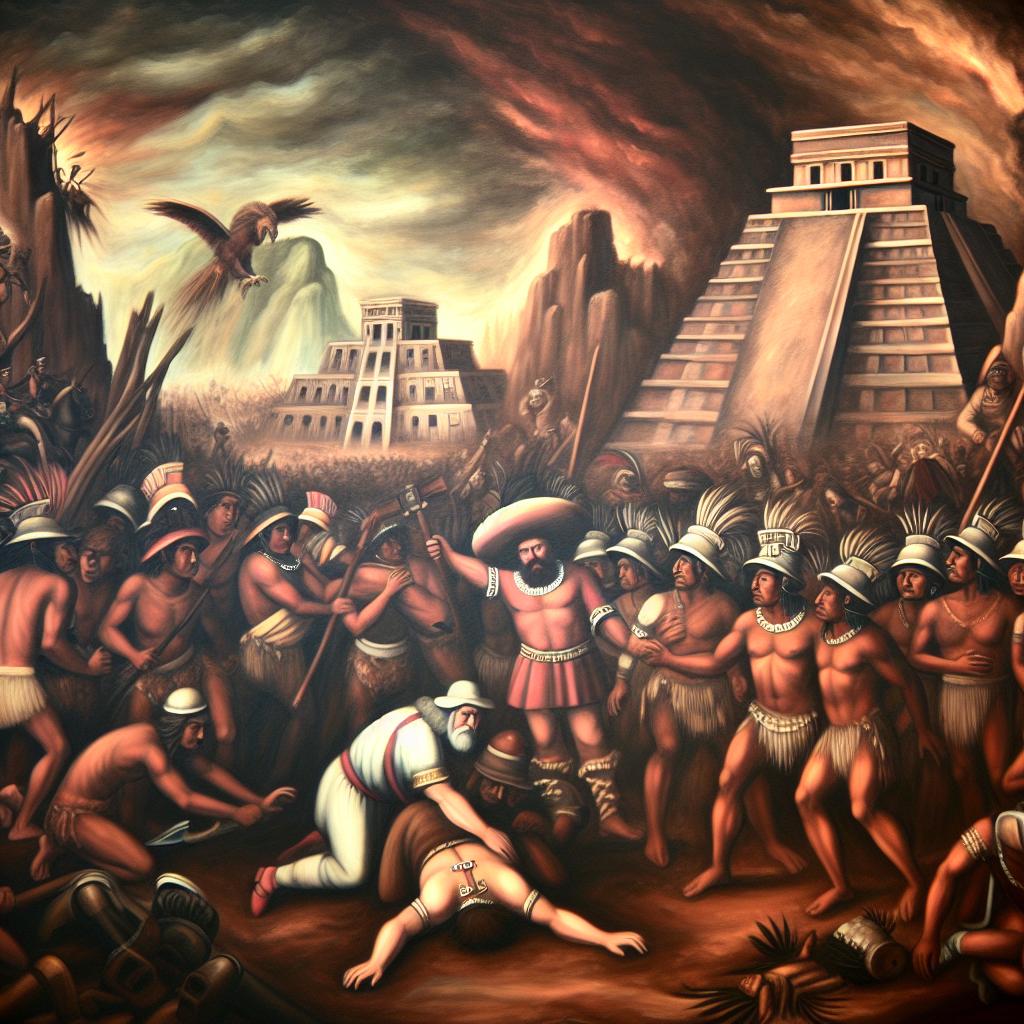The Role of Indigenous Allies
The Spanish conquest of the Aztec Empire is often attributed to the military prowess of Hernán Cortés and his well-equipped forces. However, a significant but sometimes understated factor in the success of this campaign was the role played by indigenous allies. The Spanish forces, numbering only a few hundred, faced the daunting task of subduing an empire with a population numbering in the millions. This task was made more feasible through the enlistment of various indigenous groups who had their reasons to oppose Aztec rule.
The Tlaxcalans
One of the most prominent allies of the Spanish were the Tlaxcalans. Fierce rivals of the Aztecs, the Tlaxcalans were crucial in providing not just additional manpower but also invaluable knowledge of the terrain and military tactics. Their support was instrumental during key battles, and they were a constant source of new recruits as the campaign progressed towards the Aztec capital, Tenochtitlan.
Strategic Motivations
The motivations behind the cooperation between the Spanish and indigenous groups were complex and strategic. The Aztecs had established a tributary empire that heavily taxed surrounding regions. Many of these regions, seeing an opportunity to escape Aztec dominance, lent their support to the Spanish. This collaboration was not merely opportunistic; it was also a calculated risk that the fall of the Aztecs could lead to a more favorable political environment.
Navigating New Social Dynamics
The alliance with indigenous groups necessitated a nuanced approach to social interactions. The Spanish, though technologically superior, had to negotiate with political entities that were well-established and culturally distinct. Over time, new social bonds were forged, significantly influencing the societal landscape of what would become colonial Mexico. Learn more about these alliances.
Consequences of Collaboration
While some indigenous groups expected to gain autonomy and prosperity, the outcome of their support for the Spanish was varied. The dismantling of the Aztec Empire did lead to shifts in power, but it also set the stage for Spanish colonial rule, which imposed new systems of governance and social hierarchies. Thus, the indigenous allies found themselves part of an emerging colonial structure that frequently marginally benefited them.
Long-Term Impacts
The Spanish conquest and the use of indigenous alliances fundamentally altered the demographic and cultural landscape of Mexico. Over time, these events led to significant changes in governance, religion, and daily life as European and indigenous practices merged. Although the Aztec Empire fell, many cultural elements continued to persist and evolve, ultimately shaping the identity of modern-day Mexico.
A Complex Historical Landscape
Understanding the intricate web of alliances and oppositions during the Spanish conquest unlocks insights into how indigenous groups navigated the geopolitical landscape of their time. The alliances formed were not solely due to conquest or coercion; they often involved complex negotiations and mutual benefits. For instance, while some indigenous groups were motivated by the desire to overthrow Aztec dominance, others were driven by economic opportunities or the promise of enhanced status within the new colonial order.
Transformations in Mexican Identity
The blending of cultures after the Spanish conquest represents a profound period of transformation for the region. Indigenous traditions and practices blended with European influences, creating a new cultural mosaic that still characterizes Mexican society today. This cultural fusion can be seen in various aspects of contemporary Mexican life, from language and art to culinary practices and religious observances.
The Strategic Depth of Indigenous Alliances
The contribution of indigenous allies can be analyzed through the lens of strategic depth. The alliances offered the Spanish not just additional military support but also access to logistical networks, information about local economies, and familiarity with the socio-political landscape. These factors allowed them to adapt their strategies to the complex realities on the ground, thus facilitating a prolonged campaign with relatively limited resources.
Economic Interactions
As the conquest progressed, interactions were not only military but also economic. The Spanish quickly realized the value of integrating into existing trade networks, using them to supply their forces and to slowly establish control over the region’s resources. Indigenous economies were sophisticated, with established trade routes that spanned vast distances. The Spanish capitalized on this economic infrastructure to support their military endeavors and to cement their eventual dominance.
Religious and Cultural Exchange
Beyond military and economic considerations, the conquest also initiated a significant religious and cultural exchange. Many indigenous groups adopted aspects of Christianity, often integrating it with native beliefs to create syncretic forms of religious practice. This process was not uniform and varied widely among different communities, leading to diverse expressions of faith that have persisted unto this day.
Challenges in Alliances
Despite the seeming mutual benefits, the alliances — like any political relationships — came with inherent challenges. Misunderstandings, cultural differences, and conflicting objectives sometimes led to tensions. The imposition of European norms over existing societal structures meant that indigenous groups often navigated these new dynamics in ways that prioritized immediate survival and potential long-term benefits without accurately predicting future consequences.
Learning from Past Alliances
Reflecting on the impact of these alliances provides valuable lessons for understanding the complex interactions between diverse groups in colonial contexts. The experiences of the Tlaxcalans and other indigenous allies underscore the importance of strategic partnerships, the vitality of cultural exchange, and the unintended consequences that often accompany large-scale geopolitical changes.
Studying these historical narratives enriches our appreciation of Mexico’s diverse cultural tapestry, illustrating the complex interplay of military, political, and social forces that shaped the course of history in the region. Through this exploration, we gain a deeper comprehension of both the indigenous and European influences that continue to define the Mexican cultural and historical landscape today.







